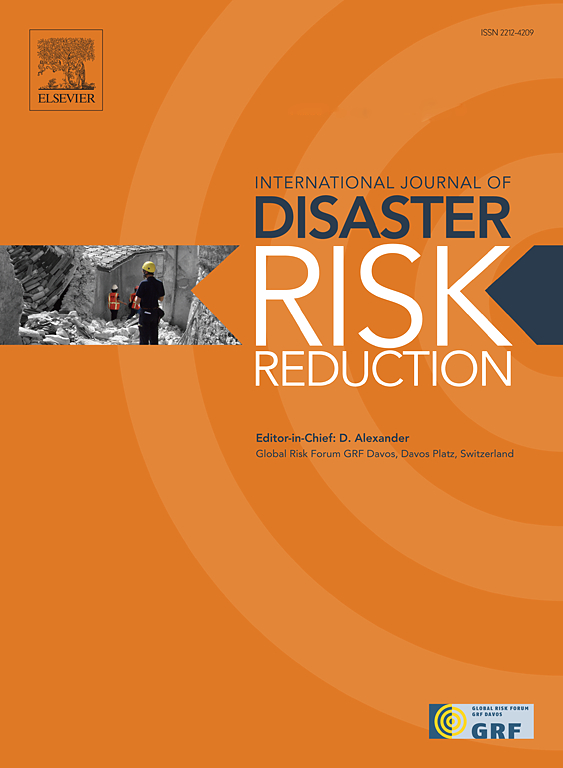地铁系统面临的日益严重的城市洪水:来自2001年至2021年中国互联网媒体记录的证据
IF 4.5
1区 地球科学
Q1 GEOSCIENCES, MULTIDISCIPLINARY
International journal of disaster risk reduction
Pub Date : 2025-05-09
DOI:10.1016/j.ijdrr.2025.105551
引用次数: 0
摘要
地铁系统作为一种重要的地下交通基础设施,在不断变化的气候条件下尤其容易受到城市洪水的影响。然而,目前对地铁易发洪水站点的特征,包括其时空分布和影响因素的认识有限。本研究通过互联网媒体大数据挖掘,提取了2001 - 2021年中国33个城市的327个地铁站洪水事件,识别了地铁洪水发生与气象、地形和下垫面因素的关系。研究发现,中国每年发生地铁站洪水的城市数量显著增加。其中,地铁站内淹水、地铁站出入口淹水和地铁站顶棚漏水分别占24.77%、60.86%和14.37%。24小时降水量为25 mm,坡度为5 ~ 15°,相对DEM<; 48%,流域面积为97.46 ~ 179.42 km2,不透水面率>; 80%,无绿地或蓝色空间,地铁车站年龄为<;5年,与这些地铁洪水事件最相关。特别是,下垫面特征是最重要的因素,突出了气候适应型城市土地利用规划的重要性。本文章由计算机程序翻译,如有差异,请以英文原文为准。
Increasing urban flooding facing metro system: Evidence from Internet media records in China from 2001 to 2021
Metro systems, as a vital type of underground transportation infrastructure, are particularly vulnerable to urban flooding in the changing climate. However, current understanding of the characteristics of flood-prone subway stations, including their spatiotemporal distribution and determinants is limited. This study, via Internet media big data mining, extracted 327 subway station flooding events in 33 cities of China from 2001 to 2021, and identified the relationship between the subway flooding occurrences and meteorological, topographical, and underlying surface factors. We found that annual subway station floodings and cities experiencing such events significantly increased in China. Among these events, flooding inside subway stations, flooding at subway station entrances and subway station ceiling leaks accounted for 24.77 %, 60.86 %, and 14.37 %, respectively. Twenty-four-hour precipitation of>25 mm, in combination with a slope of 5∼15°, relative DEM<48 %, watershed area of 97.46–179.42 km2, impervious surface ratio>80 %, no green or blue space, and age of subway station<5 years is most frequently associated with these subway flooding events. In particular, underlying surface characteristics are the most vital factors, highlighting the importance of climate-resilient urban land use planning.
求助全文
通过发布文献求助,成功后即可免费获取论文全文。
去求助
来源期刊

International journal of disaster risk reduction
GEOSCIENCES, MULTIDISCIPLINARYMETEOROLOGY-METEOROLOGY & ATMOSPHERIC SCIENCES
CiteScore
8.70
自引率
18.00%
发文量
688
审稿时长
79 days
期刊介绍:
The International Journal of Disaster Risk Reduction (IJDRR) is the journal for researchers, policymakers and practitioners across diverse disciplines: earth sciences and their implications; environmental sciences; engineering; urban studies; geography; and the social sciences. IJDRR publishes fundamental and applied research, critical reviews, policy papers and case studies with a particular focus on multi-disciplinary research that aims to reduce the impact of natural, technological, social and intentional disasters. IJDRR stimulates exchange of ideas and knowledge transfer on disaster research, mitigation, adaptation, prevention and risk reduction at all geographical scales: local, national and international.
Key topics:-
-multifaceted disaster and cascading disasters
-the development of disaster risk reduction strategies and techniques
-discussion and development of effective warning and educational systems for risk management at all levels
-disasters associated with climate change
-vulnerability analysis and vulnerability trends
-emerging risks
-resilience against disasters.
The journal particularly encourages papers that approach risk from a multi-disciplinary perspective.
 求助内容:
求助内容: 应助结果提醒方式:
应助结果提醒方式:


